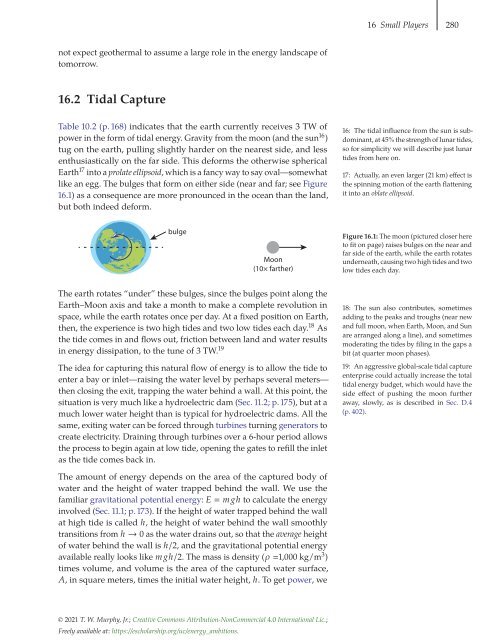Energy and Human Ambitions on a Finite Planet, 2021a
Energy and Human Ambitions on a Finite Planet, 2021a
Energy and Human Ambitions on a Finite Planet, 2021a
Create successful ePaper yourself
Turn your PDF publications into a flip-book with our unique Google optimized e-Paper software.
16 Small Players 280<br />
not expect geothermal to assume a large role in the energy l<str<strong>on</strong>g>and</str<strong>on</strong>g>scape of<br />
tomorrow.<br />
16.2 Tidal Capture<br />
Table 10.2 (p. 168) indicates that the earth currently receives 3 TW of<br />
power in the form of tidal energy. Gravity from the mo<strong>on</strong> (<str<strong>on</strong>g>and</str<strong>on</strong>g> the sun 16 )<br />
tug <strong>on</strong> the earth, pulling slightly harder <strong>on</strong> the nearest side, <str<strong>on</strong>g>and</str<strong>on</strong>g> less<br />
enthusiastically <strong>on</strong> the far side. This deforms the otherwise spherical<br />
Earth 17 into a prolate ellipsoid, which is a fancy way to say oval—somewhat<br />
like an egg. The bulges that form <strong>on</strong> either side (near <str<strong>on</strong>g>and</str<strong>on</strong>g> far; see Figure<br />
16.1) as a c<strong>on</strong>sequence are more pr<strong>on</strong>ounced in the ocean than the l<str<strong>on</strong>g>and</str<strong>on</strong>g>,<br />
but both indeed deform.<br />
16: The tidal influence from the sun is subdominant,<br />
at 45% the strength of lunar tides,<br />
so for simplicity we will describe just lunar<br />
tides from here <strong>on</strong>.<br />
17: Actually, an even larger (21 km) effect is<br />
the spinning moti<strong>on</strong> of the earth flattening<br />
it into an oblate ellipsoid.<br />
bulge<br />
Mo<strong>on</strong><br />
(10× farther)<br />
Figure 16.1: The mo<strong>on</strong> (pictured closer here<br />
to fit <strong>on</strong> page) raises bulges <strong>on</strong> the near <str<strong>on</strong>g>and</str<strong>on</strong>g><br />
far side of the earth, while the earth rotates<br />
underneath, causing two high tides <str<strong>on</strong>g>and</str<strong>on</strong>g> two<br />
low tides each day.<br />
The earth rotates “under” these bulges, since the bulges point al<strong>on</strong>g the<br />
Earth–Mo<strong>on</strong> axis <str<strong>on</strong>g>and</str<strong>on</strong>g> take a m<strong>on</strong>th to make a complete revoluti<strong>on</strong> in<br />
space, while the earth rotates <strong>on</strong>ce per day. At a fixed positi<strong>on</strong> <strong>on</strong> Earth,<br />
then, the experience is two high tides <str<strong>on</strong>g>and</str<strong>on</strong>g> two low tides each day. 18 As<br />
the tide comes in <str<strong>on</strong>g>and</str<strong>on</strong>g> flows out, fricti<strong>on</strong> between l<str<strong>on</strong>g>and</str<strong>on</strong>g> <str<strong>on</strong>g>and</str<strong>on</strong>g> water results<br />
in energy dissipati<strong>on</strong>, to the tune of 3 TW. 19<br />
The idea for capturing this natural flow of energy is to allow the tide to<br />
enter a bay or inlet—raising the water level by perhaps several meters—<br />
then closing the exit, trapping the water behind a wall. At this point, the<br />
situati<strong>on</strong> is very much like a hydroelectric dam (Sec. 11.2; p. 175), but at a<br />
much lower water height than is typical for hydroelectric dams. All the<br />
same, exiting water can be forced through turbines turning generators to<br />
create electricity. Draining through turbines over a 6-hour period allows<br />
the process to begin again at low tide, opening the gates to refill the inlet<br />
as the tide comes back in.<br />
18: The sun also c<strong>on</strong>tributes, sometimes<br />
adding to the peaks <str<strong>on</strong>g>and</str<strong>on</strong>g> troughs (near new<br />
<str<strong>on</strong>g>and</str<strong>on</strong>g> full mo<strong>on</strong>, when Earth, Mo<strong>on</strong>, <str<strong>on</strong>g>and</str<strong>on</strong>g> Sun<br />
are arranged al<strong>on</strong>g a line), <str<strong>on</strong>g>and</str<strong>on</strong>g> sometimes<br />
moderating the tides by filing in the gaps a<br />
bit (at quarter mo<strong>on</strong> phases).<br />
19: An aggressive global-scale tidal capture<br />
enterprise could actually increase the total<br />
tidal energy budget, which would have the<br />
side effect of pushing the mo<strong>on</strong> further<br />
away, slowly, as is described in Sec. D.4<br />
(p. 402).<br />
The amount of energy depends <strong>on</strong> the area of the captured body of<br />
water <str<strong>on</strong>g>and</str<strong>on</strong>g> the height of water trapped behind the wall. We use the<br />
familiar gravitati<strong>on</strong>al potential energy: E mgh to calculate the energy<br />
involved (Sec. 11.1; p. 173). If the height of water trapped behind the wall<br />
at high tide is called h, the height of water behind the wall smoothly<br />
transiti<strong>on</strong>s from h → 0 as the water drains out, so that the average height<br />
of water behind the wall is h/2, <str<strong>on</strong>g>and</str<strong>on</strong>g> the gravitati<strong>on</strong>al potential energy<br />
available really looks like mgh/2. The mass is density (ρ 1,000 kg/m 3 )<br />
times volume, <str<strong>on</strong>g>and</str<strong>on</strong>g> volume is the area of the captured water surface,<br />
A, in square meters, times the initial water height, h.Togetpower,we<br />
© 2021 T. W. Murphy, Jr.; Creative Comm<strong>on</strong>s Attributi<strong>on</strong>-N<strong>on</strong>Commercial 4.0 Internati<strong>on</strong>al Lic.;<br />
Freely available at: https://escholarship.org/uc/energy_ambiti<strong>on</strong>s.


















